






 Hãng kiến trúc Remistudio của Nga đã thiết kế một khách sạn nổi trên mặt nước và chống chịu mọi thảm họa mang tính hủy diệt của môi trường.
Hãng kiến trúc Remistudio của Nga đã thiết kế một khách sạn nổi trên mặt nước và chống chịu mọi thảm họa mang tính hủy diệt của môi trường.




















Những ngôi nhà kỳ dị

Federation Square is a cultural precinct in the city of Melbourne, Australia






 (http://www.axxyc.com/forum/50-bangunan-teraneh-di-dunia-part-II)
(http://www.axxyc.com/forum/50-bangunan-teraneh-di-dunia-part-II)

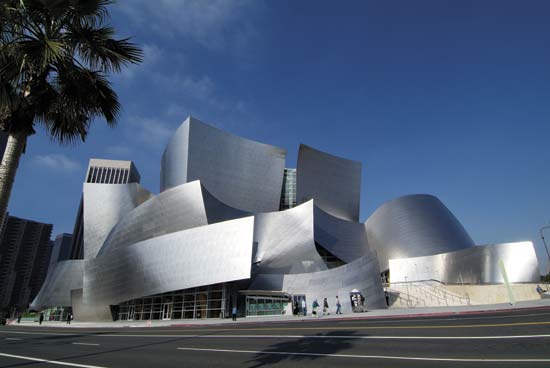

The Walt Disney Concert Hall at 111 South Grand Avenue in Downtown Los Angeles, California


The Spaceship House, in Chattanooga (TN, USA).

The Teapot Dome, in Zillah (WA, USA). It was built in 1922 as a reminder of the Teapot Dome Scandal involving President Warren G. Harding and a federal petroleum reserve in Wyoming.

The Boeing 727 House, in Benoit (Mississippi, USA). The plane set Joanne Ussary back $2,000.00, cost $4,000.00 to move, and $24,000.00 to renovate. The stairs open with a garage door remote, and one of the bathrooms is still intact. And let’s not forget the personal jacuzzi in the cockpit.

The Toilet-shaped house, in Suwon (South Korea). South Korean sanitation activists marked the start of a global toilet association right here on November 21, 2007, by lifting the lid on the world's first lavatory-shaped home that offers plenty of water closet space.

The Nautilus House, in Mexico DF (Mexico), is a seashell-inspired abode built by designed by Senosiain Arquitectos for a couple.

The Shoe House in Hellam (Pennsylvania, USA). It was an actual guesthouse (3 bedroom, 2 baths, a kitchen and a living room) of a local shoe magnate, Mahlon N. Haines. After his death, it was an ice cream parlor for a while, and now it is a museum.

The Upside-Down House, in Szymbark (Poland). The house was created by Daniel Czapiewski to describe the former communist era and the present times in which we live.

The Cube houses, in Rotterdam (Holland). All of this 32 cube houses are attached to each other. Designed by architect Piet Blom in 1984, each cube house has three floors.

The Bubble House in Cannes (France). In the early eighties, fashion designer Pierre Cardin bought this atypical summer house built by architect Antti Lovag.

The Eliphante Art House, in Cornville (AZ, USA). Artist Michael Kahn and his wife Leda Livant built it from found materials piece by piece.

The Mushroom House, in Cincinnati (Ohio, USA).

The One Log House, in Garberville (California, USA). It is a one-bedroom house hollowed out from a single log that came from a 2,100-year old redwood tree. After felling this 13 foot diameter forest giant, Art Schmock and a helper needed 8 months of hard labor to hollow out the log into a room 7 ft. high and 32 ft. long, weighing about 42 tons.

The Fallingwater, in Pennsylvania (USA). It was designed by American architect Frank Lloyd Wright in 1935 and built partly over a waterfall.

The Steel House, in Lubbock (Texas, USA). Architect and sculptor Robert Bruno spent 23 years building this strange home that looks like a giant pig out of 110 tons of steel.

The Pickle Barrel House, in Michigan (USA).

The Strawberry house, in Tokyo (Japan).

The Errante's Guest House, in Chile.

The Kettle House, in Texas (USA).

The Kvivik Igloo, in Kvivik (Faroe Islands)



 2. Wooden Gagster House ( Archangelsk , Rússia )
2. Wooden Gagster House ( Archangelsk , Rússia ) 
 4. Estádio Olímpico (Montreal, Quebec - Canadá)
4. Estádio Olímpico (Montreal, Quebec - Canadá)  5. Tenerife Concert Hall (Santa Cruz de Tenerife - Ilhas Canárias - Espanha)
5. Tenerife Concert Hall (Santa Cruz de Tenerife - Ilhas Canárias - Espanha)  6. Flying House - A casa do vôo (Sarzana,Itália)
6. Flying House - A casa do vôo (Sarzana,Itália) 
 8. Cob House (Vancouver - Canadá)
8. Cob House (Vancouver - Canadá) 
 10. Casa do Comércio (Salvador, Bahia, Brasil)
10. Casa do Comércio (Salvador, Bahia, Brasil) 
 12. Stata Center (Cambridge, Massachusetts, EUA)
12. Stata Center (Cambridge, Massachusetts, EUA)  13. Glass House (Boswell, B.C., Canadá)
13. Glass House (Boswell, B.C., Canadá)  14. Beer Can House (Houston, Texas, EUA)
14. Beer Can House (Houston, Texas, EUA)  15. Strawberry Ice-cream shop (NC, EUA)
15. Strawberry Ice-cream shop (NC, EUA)  16. Strawberry house (Tóquio, Japão)
16. Strawberry house (Tóquio, Japão)  17. Sculptured House (Colorado, EUA)
17. Sculptured House (Colorado, EUA)  18. Nautilus House (Cidade do México, México)
18. Nautilus House (Cidade do México, México)  19. Kvivik Igloo (Kvivik, Ilhas Faroé)
19. Kvivik Igloo (Kvivik, Ilhas Faroé)  20. Modern Igloo (Alaska, EUA)
20. Modern Igloo (Alaska, EUA)  21. Atomium (Bruxelas, Bélgica)
21. Atomium (Bruxelas, Bélgica)  22. Catedral de Brasília (Brasil)
22. Catedral de Brasília (Brasil)  23. Arco da Defesa (Paris, França)
23. Arco da Defesa (Paris, França)  24. La Pedrera (Barcelona, Espanha)
24. La Pedrera (Barcelona, Espanha)  25. Errante Guest House (Chile)
25. Errante Guest House (Chile)  26. Museu de Arte Moderna e Contemporânea (Nice, França)
26. Museu de Arte Moderna e Contemporânea (Nice, França)  27. Torre Agbar (Barcelona, Espanha)
27. Torre Agbar (Barcelona, Espanha)  28. The Museum of Play (Rochester , EUA)
28. The Museum of Play (Rochester , EUA)  29. Bubble House (Bay Area of Califórnia, EUA)
29. Bubble House (Bay Area of Califórnia, EUA)  30. Raffles Dubai na cidade de Wafi (Dubai, EAU)
30. Raffles Dubai na cidade de Wafi (Dubai, EAU)  31. Atlantis (Dubai, EAU)
31. Atlantis (Dubai, EAU)  32. Casa da Música (Porto, Portugal)
32. Casa da Música (Porto, Portugal)  33. Berlin Zeiss Planetarium (Berlim, Alemanha)
33. Berlin Zeiss Planetarium (Berlim, Alemanha)  34. Eden Project (Reino Unido)
34. Eden Project (Reino Unido)  35. Torre Kobe Port (Japão)
35. Torre Kobe Port (Japão)  36. Cybertecture Egg (Mumbai, Índia)
36. Cybertecture Egg (Mumbai, Índia)  37. Kunsthaus (Graz, Áustria)
37. Kunsthaus (Graz, Áustria)  38. The Esplanade (Singapura)
38. The Esplanade (Singapura)  39. Office center “1000″ a.k.a. Banknote (Kaunas, Lituânia)
39. Office center “1000″ a.k.a. Banknote (Kaunas, Lituânia)  40. Blur Building (Yverdon-les-Bainz, Suiça)
40. Blur Building (Yverdon-les-Bainz, Suiça)  41. Edifício Mirador (Madrid, Espanha)
41. Edifício Mirador (Madrid, Espanha)  42. Torres A Porta da Europa (Madrid, Espanha)
42. Torres A Porta da Europa (Madrid, Espanha)  43. Turning Torso (Malmö, Suécia)
43. Turning Torso (Malmö, Suécia)  44. Great Mosque of Djenné (Djenne, Mali)
44. Great Mosque of Djenné (Djenne, Mali)  45. Montreal Biosphère (Canadá)
45. Montreal Biosphère (Canadá) 

 48. Centro Civil de Justiça (Manchester, Reino Unido)
48. Centro Civil de Justiça (Manchester, Reino Unido)  49. Cidade-templo (Ankgor Wat, Cambodja)
49. Cidade-templo (Ankgor Wat, Cambodja) 
 51. Weird House nos Alpes
51. Weird House nos Alpes  52. Hotel Ryugyong (Pyongyang, Coreia do Norte)
52. Hotel Ryugyong (Pyongyang, Coreia do Norte)  53. Grand Lisboa (Macau)
53. Grand Lisboa (Macau)  54. Wall House (Groningen, Holanda)
54. Wall House (Groningen, Holanda)  55. Museu Guggenheim (Bilbao, Espanha)
55. Museu Guggenheim (Bilbao, Espanha)  56. Container City (Londres, Reino Unido)
56. Container City (Londres, Reino Unido)  57. Solar Furnace (Odeillo, França)
57. Solar Furnace (Odeillo, França)  58. Dome House (Florida, EUA)
58. Dome House (Florida, EUA)  59. Estádio Nacional de Pequim (Pequim, China)
59. Estádio Nacional de Pequim (Pequim, China)  60. Fashion Show Mall (Las Vegas, EUA)
60. Fashion Show Mall (Las Vegas, EUA)  61. Luxor Hotel & Casino (Las Vegas, EUA)
61. Luxor Hotel & Casino (Las Vegas, EUA)  62. Zenith Europe (Estrasburgo, França)
62. Zenith Europe (Estrasburgo, França)  63. Centro Cívico (Santa Mónica)
63. Centro Cívico (Santa Mónica)  64. The Egg (Empire State Plaza, Albany, Nova Iorque, EUA)
64. The Egg (Empire State Plaza, Albany, Nova Iorque, EUA)  65. Gherkin Building (Londres, Reino Unido)
65. Gherkin Building (Londres, Reino Unido)  66. Lloyd’s building (Londres, Reino Unido)
66. Lloyd’s building (Londres, Reino Unido)  67. Druzhba Holiday Center Hall (Yalta, Ucrânia)
67. Druzhba Holiday Center Hall (Yalta, Ucrânia)  68. UCSD Geisel Library (San Diego, Califórnia, EUA)
68. UCSD Geisel Library (San Diego, Califórnia, EUA)  69. Ripley’s Building (Niagara Falls, Ontário, Canadá)
69. Ripley’s Building (Niagara Falls, Ontário, Canadá)  70. Dancing Building (Praga, República Checa)
70. Dancing Building (Praga, República Checa) 
 72- La Alacena de Mamá (Natchez, EUA)
72- La Alacena de Mamá (Natchez, EUA) 73- Casa Sapato (Pensilvânia, EUA)
73- Casa Sapato (Pensilvânia, EUA) 
 75. Edifício Televisião Fuji (Tóquio, Japão)
75. Edifício Televisião Fuji (Tóquio, Japão)  76. The Mushroom House aka Tree House (Cincinnati, Ohio, EUA)
76. The Mushroom House aka Tree House (Cincinnati, Ohio, EUA)  77. Free Spirit Spheres (Qualicum Beach, BC, Canadá)
77. Free Spirit Spheres (Qualicum Beach, BC, Canadá) 

 80. Biblioteca Nacional (Minsk, Bielorrússia)
80. Biblioteca Nacional (Minsk, Bielorrússia)  81. A Máquina de Lavar (México)
81. A Máquina de Lavar (México) 
 83. Teapot Dome, Gas Station. Zillah, WA, EUA
83. Teapot Dome, Gas Station. Zillah, WA, EUA  84- Conch-Shell, Isla Mujeres. México.
84- Conch-Shell, Isla Mujeres. México.  85. Puzzling World Lake Wanaka (Otago, Nova Zelândia)
85. Puzzling World Lake Wanaka (Otago, Nova Zelândia)  86. Experience-Music-Project-Seattle-WA-EUA
86. Experience-Music-Project-Seattle-WA-EUA 
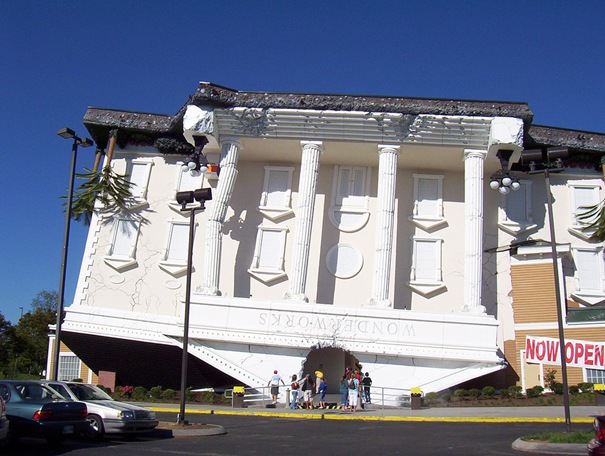




Diglets in Pokemon.

TP HCM khởi công 18 công trình giao thông năm 2011
Cầu Sài Gòn 2 với 6 làn xe, có vốn đầu tư hơn 1.500 tỷ đồng sẽ được khởi công trong năm nay. 17 công trình giao thông trọng điểm khác của thành phố cũng sẽ được tiến hành.
Theo đó, cầu Sài Gòn 2 có kiểu dáng giống cầu Sài Gòn hiện hữu, dự kiến nằm song song về phía hạ nguồn, dài khoảng 1.500 m (cầu chính dài khoảng 995 m, rộng 23,5 m) với 6 làn xe lưu thông.
 |
| Phối cảnh Cầu Sài Gòn 2. |
Tại buổi lễ tổng kết chiều 6/1, Sở Giao thông Vận tải TP HCM đánh giá đây là một trong những công trình trọng điểm của thành phố trong năm tới. Khi cầu Sài Gòn 2 được xây dựng xong sẽ giảm tải rất lớn cho cầu Sài Gòn hiện bị quá tải, giúp giao thông từ trung tâm thành phố ra xa lộ Hà Nội để đi miền Bắc được thông suốt.
Một dự án khác là nâng cấp cải tạo mặt đường bờ Bắc và bờ Nam kênh Nhiêu Lộc - Thị Nghè (đoạn từ cầu Lê Văn Sỹ đến Nguyễn Hữu Cảnh), cầu Phước Lộc (Nhà Bè). Mục tiêu là nhằm nâng cao mạng lưới giao thông khu vực và cải thiện cảnh quan đô thị dọc bờ kênh. Theo đó, điểm đầu của dự án hợp lưu tiếp giáp với đường Lê Bình và đường Út Tịch, điểm cuối là đường Lê Văn Sỹ với chiều dài khoảng 5 km, chiều rộng 16 m (bao gồm cả vỉa hè).
Ngoài ra, hàng loạt các công trình cũng được đầu tư như nút giao thông ngã tư Thủ Đức (cửa ngõ phía Đông Sài Gòn) được mở rộng 34m, bố trí vòng xoay trên cầu vượt nhằm giảm nạn ách tắc giao thông thường xuyên tại khu vực cửa ngõ này; xây dựng bổ sung một số hạng mục giao thông trên tuyến quốc lộ 1A...
 |
| Phối cảnh đường bờ kênh Nhiêu Lộc - Thị Nghè. |
Cũng theo Sở GTVT trong năm 2011, TP HCM sẽ phấn đấu đưa vào khai thác sử dụng các công trình, dự án chưa hoàn thành như: đường nối từ cầu Phú Mỹ đến cầu Rạch Chiếc, tỉnh lộ 10, cầu Suối Cái, cầu Phú Long, nút giao thông Gò Dưa... Trong đó còn có đường Liên cảng A5 - một những công trình thi công kéo dài nhất của TP HCM, được bắt đầu từ năm 2000 với việc thi công 3 km đường nhưng đã bị ngừng trệ vì liên quan đến tiêu cực “rút ruột” công trình.
Tại buổi lễ, Sở GTVT cũng đánh giá trong năm qua, thành phố đã hoàn thành nhiều công trình trọng điểm, góp phần từng bước hoàn chỉnh hệ thống hạ tầng giao thông đô thị, góp phần kéo giảm ùn tắc giao thông. Cụ thể như toàn bộ dự án cầu Thủ Thiêm, đường Nguyễn Văn Trỗi - Nam Kỳ Khởi Nghĩa, nút giao thông khu A Nam Sài Gòn, nút giao Cát Lái, đường song hành quốc lộ 22, cầu Hoàng Hoa Thám...
 |
| Công trình mở rộng đường Nam Kỳ Khởi - Nguyễn Văn Trỗi kết nối sân bay Tân Sơn Nhất với trung tâm TP HCM hoàn thành, góp phần giảm áp lực kẹt xe cho TP HCM. Ảnh: Vĩnh Phú. |
Tuy nhiên, Sở cũng nhìn nhận vẫn còn một số công trình trọng điểm đang triển khai với tiến độ chậm. Nguyên nhân chính vẫn là công tác bồi thường giải phóng mặt bằng do các quận, huyện thực hiện chậm nên nhiều công trình tạm ngưng thi công hoặc chậm khởi công xây dựng mặc dù đã hoàn tất các thủ tục như: đường nối Tân Sơn Nhất - Bình Lợi - Vành đai ngoài, nút giao thông Gò Dưa, nâng cấp mở rộng tỉnh lộ 10, xây dựng đường tỉnh lộ 10B, đường Phạm Văn Bạch...
Ông Vũ Xuân Cường - Phó giám đốc Sở GTVT TP HCM cho biết, bên cạnh việc phải đẩy nhanh tốc độ giải phóng mặt bằng, việc cân đối nguồn vốn dành cho các công trình giao thông trong năm 2011 cũng sẽ gặp nhiều khó khăn nên sẽ thực hiện nhiều nhóm giải pháp.
"Thành phố sẽ tiếp tục tăng cường phát triển diện tích mặt đường, hoàn thiện hệ thống giao thông thành phố bằng cách tập trung xây dựng, nâng cấp mở rộng các tuyến đường hướng tâm, tuyến đường cửa ngõ thành phố, các đường nối các đô thị vệ tinh... xây dựng các đường cao tốc trên cao, đường xuyên tâm", ông Cường nói.
Hiện nay, TP HCM cũng đang kêu gọi đầu tư vào lĩnh vực hạ tầng giao thông đô thị như các dự án đường sắt đô thị, monorail, các đoạn tuyến đường vành đai số 2, số 3, các tuyến đường trên cao...
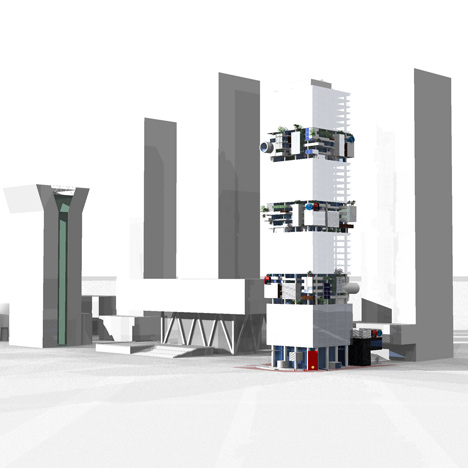
Adjacent to the Town Hall and its main North-South axis, and located on East-West oriented Shen Nan Avenue, it has the pole position in the central quarter in Shenzhen, where in midst the stock exchange building dominates.
The SFB Tower building contrasts to the stock exchange building. In actual fact it contrasts to any highrise in the vicinity because it is different. With its memorable design in an exposed corner position of the cluster, it becomes a dominant statement within the highrises.
The tower building in plan is a simple square of 45 m x 45 m, with 42 floors and an overall height of 200 m and it features a total floor area of 80.500 m² above ground. A skirt building partially frames the tower in the base zone, where the entrance area, the public business hall and a high class restaurant are located.
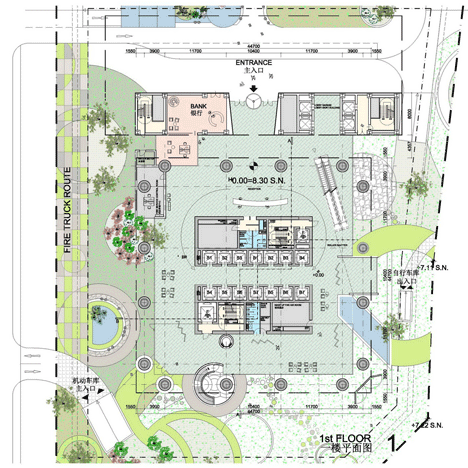
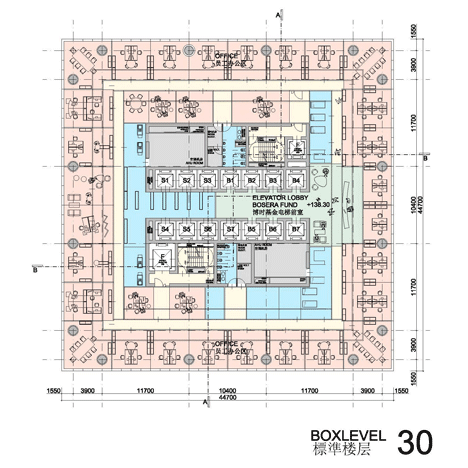
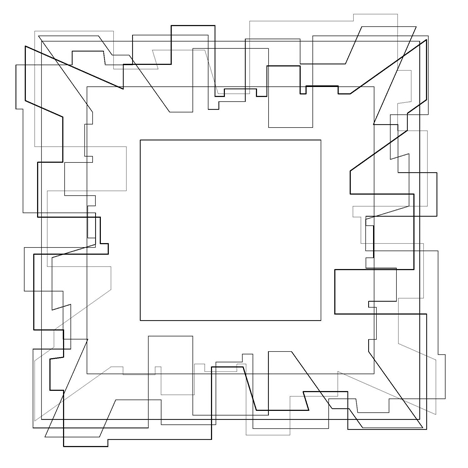
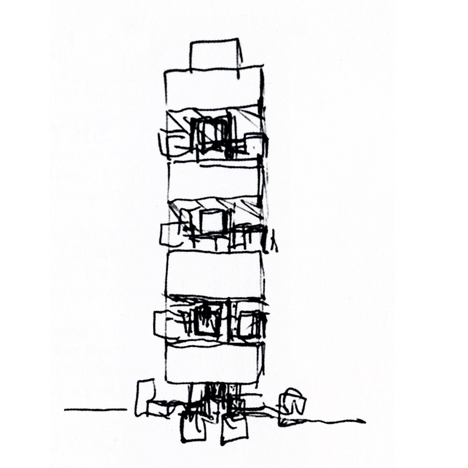
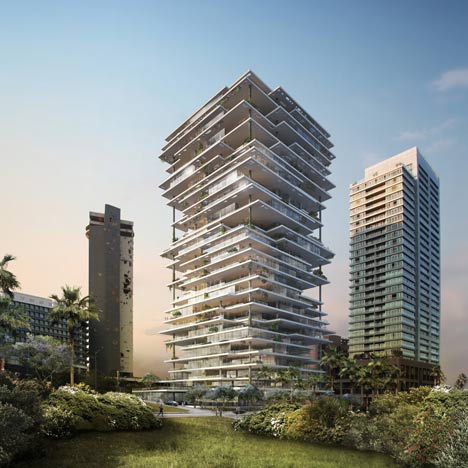
Swiss architects Herzog and de Meuron have designed this apartment tower with overhanging floor plates and terraces for Beirut, Lebanon.
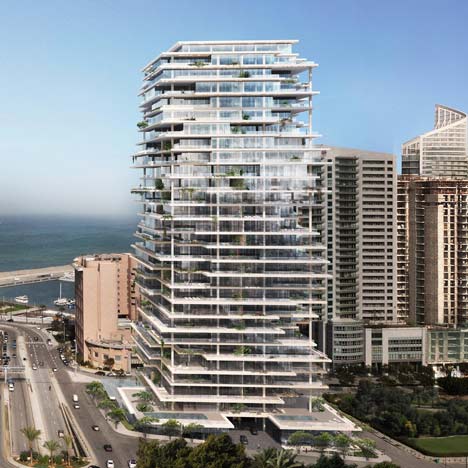
Created as part of a wider masterplan to regenerate this area of the city that includes a marina, the building will comprise five different modular floor slabs used in varying combinations to create a mixture of overhangs and terraces.
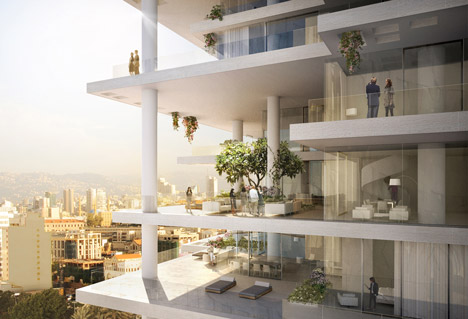
The building will have vegetation on the terraces to provide privacy and in the main entrance space to act as continuation of the neighbouring green boulevard.
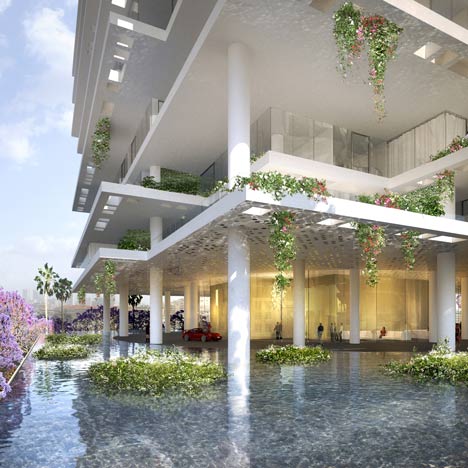
The 116 metre-high structure will be supported by columns on a 14.7 metre regular grid, with each floor plate overhanging the glazing by at least 60 centimetres.

129 single, duplex and townhouse apartments will be available, arranged in different clusters throughout the tower.
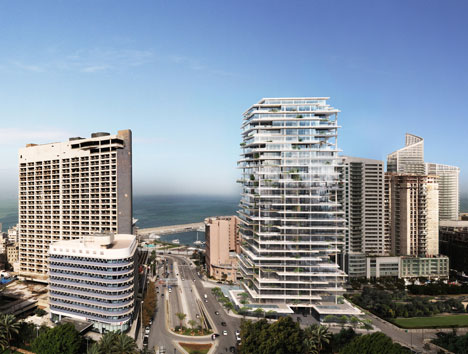
The project is due for completion in 2013.
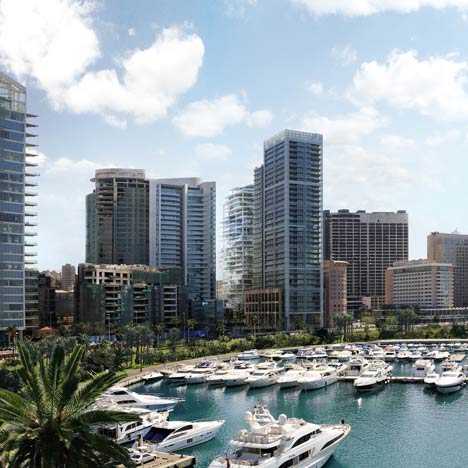

Steven Holl Architects have completed a building conceived as a “horizontal skyscraper”, supported over a landscaped garden in Shenzhen, China.

The project has been awarded with a 2010 Honor Award by the American Institute of Architects (AIA) New York Chapter. Holl’s Knut Hamsun Center at Hamarøy (see our earlier story) will also be awarded at the ceremony in April.
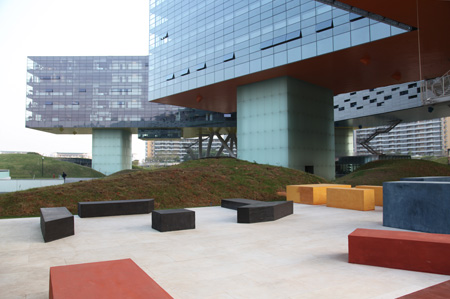
Called Vanke Center Shenzhen, the building is as long as the Empire State Building is tall, and includes apartments, offices and a hotel, with a conference centre, spa and car park below ground level.
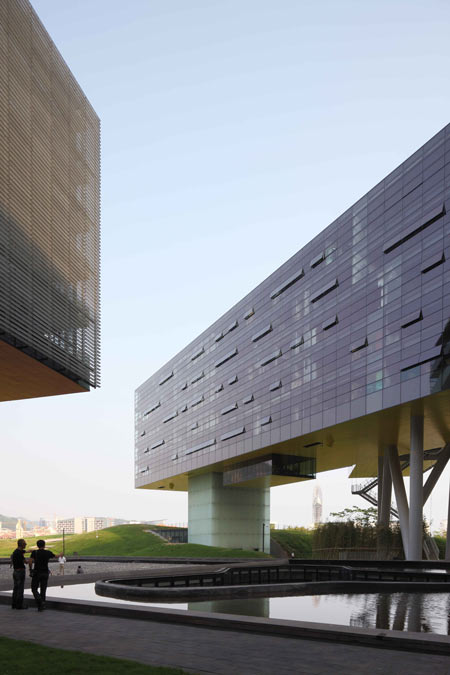
The structure spreads out under the 35 meter height limit on the site, supported on eight cores using bridge-building technology and a concrete frame to maximise the area available for gardens beneath.
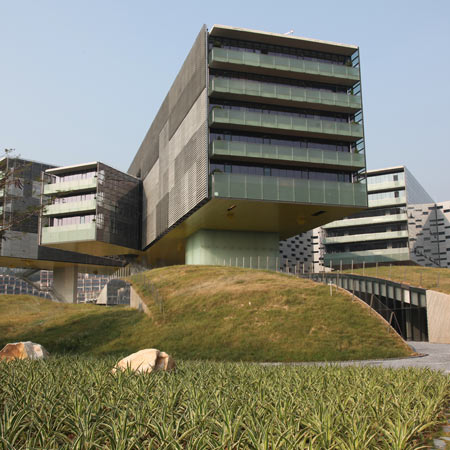
Photographs are by Shu He, Courtesy Steven Holl Architects.
Here’s some more information from Steven Holl Architects:
Vanke Center Shenzhen,
China 2006 – 2009
Hovering over a tropical garden, this ‘horizontal skyscraper’ –as long as the Empire State Building is tall- unites into one vision the headquarters for Vanke Co. ltd, office spaces, apartments, and a hotel. A conference center, spa and parking are located under the large green, public landscape.
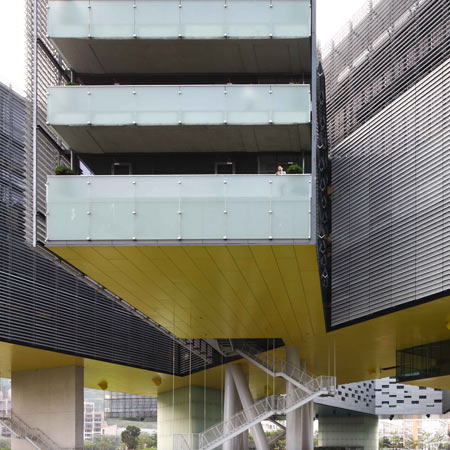
The building appears as if it were once floating on a higher sea that has now subsided; leaving the structure propped up high on eight legs.
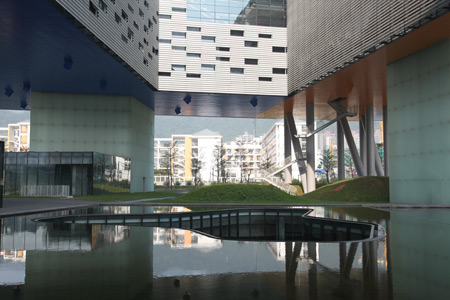
The decision to float one large structure right under the 35-meter height limit, instead of several smaller structures each catering to a specific program, was inspired by the hope to create views over the lower developments of surrounding sites to the South China Sea, and to generate the largest possible green space open to the public on the ground level.
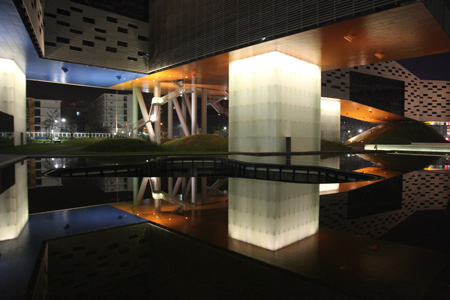
Advanced structural technologies and construction techniques opened up the new type of flying architecture that introduces a new urban layer to Shenzhen.
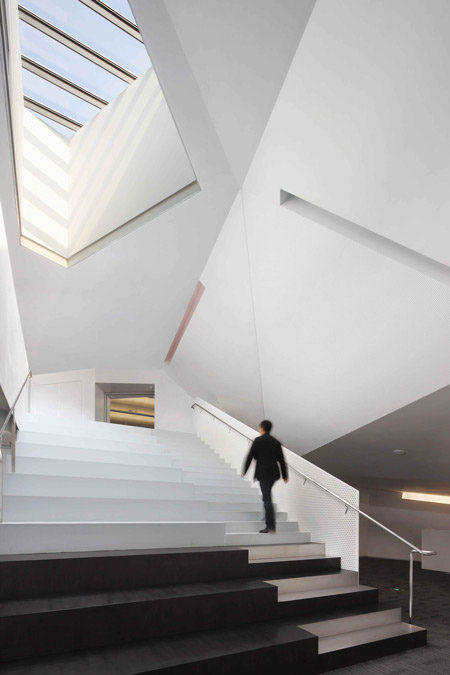
Suspended on eight cores, as far as 50 meters apart, this floating horizontal skyscraper is a sophisticated combination of “cable-stay” bridge technology merged with a high strength concrete frame: a structure without trusses.
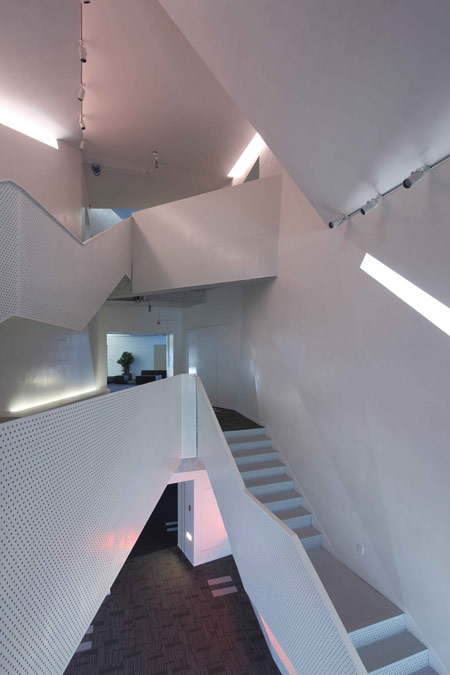
The underside of the floating structure becomes its main elevation from which sunken glass cubes, the so-called ‘Shenzhen Windows’, offer 360-degree views over the lush tropical landscape below.

Covering the entire length of the building a public path has been proposed to connect through the hotel, and the apartment zones up to the office wings.

The floating horizontal building allows sea and land breezes to pass through the public gardens. The landscape, inspired by Roberto Burle Marx’ gardens in Brazil contains restaurants and cafes in vegetated mounds bracketed with pools and walkways.
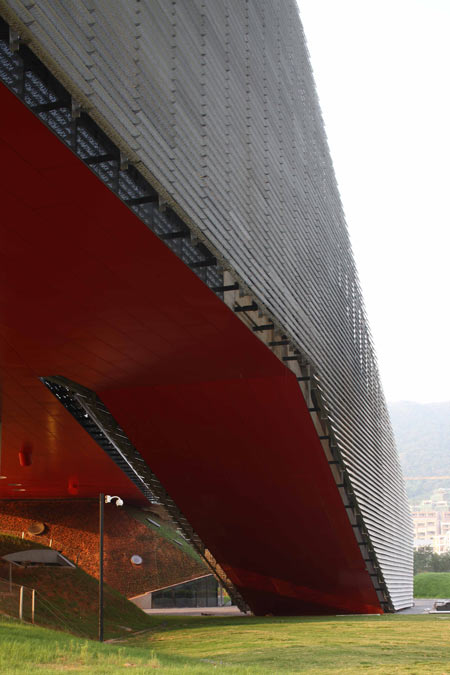
At night a walk through this landscape of flowering tropical plants will mix the smell of Jasmine with the colorful glow of the undersides of the structure floating above.

Under the landscape diverse semi-public functions create lively spaces. A large conference center includes a foamed-aluminum auditorium with green mohair seating that seats 400 people. There is a large spa with indoor and outdoor pools, and a polychromatic bar with large pivoting doors of 4.8 meters high that feel like giant lacquered paintings.
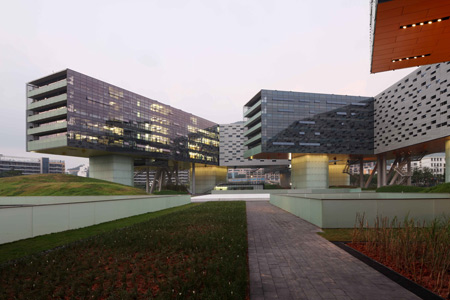
The ceiling of dark cobalt blue contrasts with walls in Chinese red and hand-applied gold leaf.
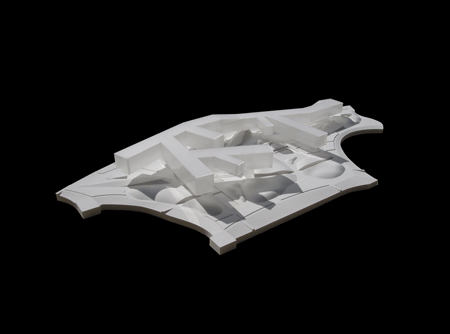
As a tropical, sustainable 21st century vision the building and the landscape integrate several new sustainable aspects. A microclimate is created by rectangular cooling lakes fed by a greywater system. The building itself has a green roof with solar panels and widely uses sustainable materials such as bamboo.
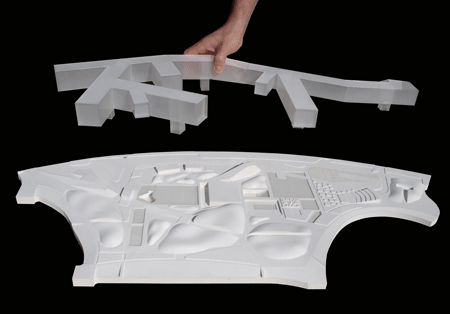
The glass façade of the building will be protected against the sun and wind by porous louvers. The Vanke Headquarter wing of the floating horizontal skyscraper is aimed at LEED Platinum. The Vanke Center is a Tsunami-proof 21st century hovering architecture that creates a porous micro-climate of freed landscape.
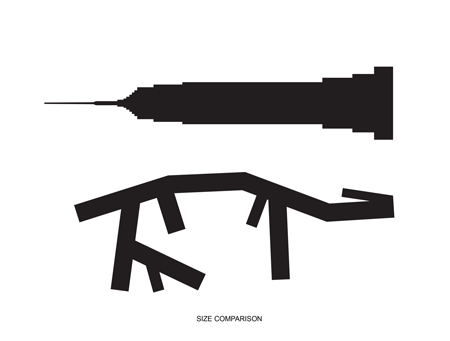
Horizontal Skyscraper/Vanke Center in Shenzhen, China:
Steven Holl Architects has been awarded two 2010 Honor Awards from the American Institute of Architects (AIA) New York Chapter for the Horizontal Skyscraper in Shenzhen, China and the Knut Hamsun Center in Hamarøy, Norway.
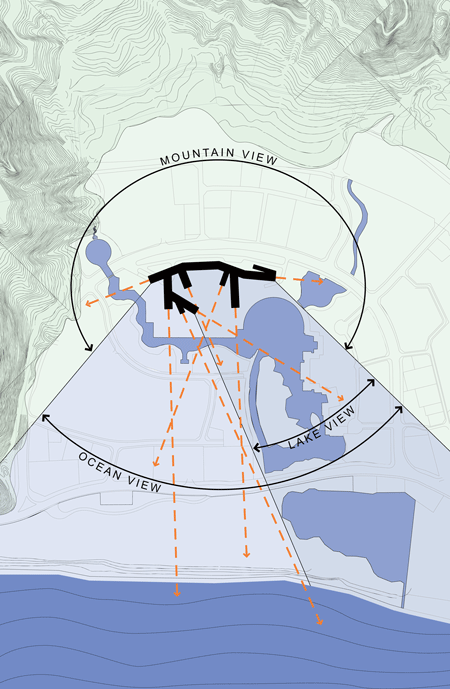
The Horizontal Skyscraper, completed in December 2009, is as long as the Empire State Building is tall, and as one of the first LEED platinum rated buildings in Southern China, it recently received a 2010 Good Design is Good Business China Award for Best Green project.
The Knut Hamsun Center, completed August 2009, is dedicated to Knut Hamsun and includes exhibition areas, a library and reading room, a café, and an auditorium. The building is conceived as an archetypal and intensified compression of spirit in space and light, concretizing a Hamsun character in architectonic terms.
The winning Design Award projects will be recognized at the annual Design Awards Luncheon on Wednesday, April 14th. All winning work will be exhibited at the Center for Architecture, 536 LaGuardia Place. The Design Awards Exhibition will be on view from Thursday, April 15 through July 3, 2010.
program: mixed-use building including hotel, offices, condominiums, and public park
project type: competition
building area (square): 1296459sf/120445sm
landscape area (square): 559723sf/52000sm
public green space (square): 509004sf/47288sm
size conference center (square): 89254sf/8292sm
size condominiums (square): 276676sf/25704sm
size hotel (square): 119619sf/11113sm
size soho offices (square): 146292sf/13591sm
size vanke headquarters: 149338sf/13874sm
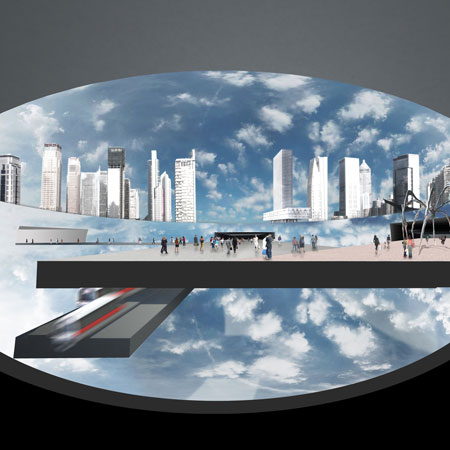
Dutch architects Office for Metropolitan Architecture and Chinese practice Urbanus have won a competition for a new cultural centre and transport hub in Shenzhen, China.
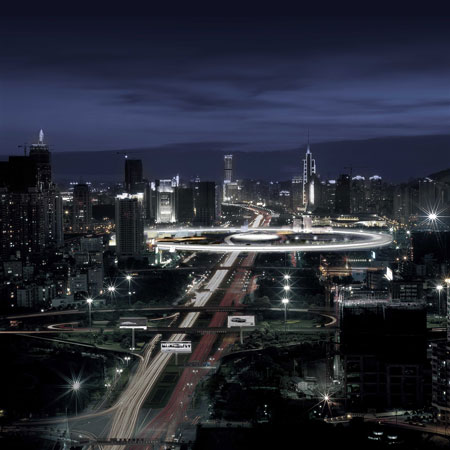
See all our stories about OMA/Rem Koolhaas in our special category.
Images: Shenzhen Crystal Island © OMA / Ole Scheeren.
Here’s some info from OMA:
–
OMA wins Shenzhen Crystal Island competition
Beijing / Rotterdam, 17 June 2009 – The Office for Metropolitan Architecture (OMA), in collaboration with Shenzhen-based architects Urbanus, has been awarded first prize in the design competition for a major new cultural center, transport hub, and public landmark in the heart of the city of Shenzhen, southern China. The design, led by OMA partner Ole Scheeren, was selected from 32 entries by an international jury.
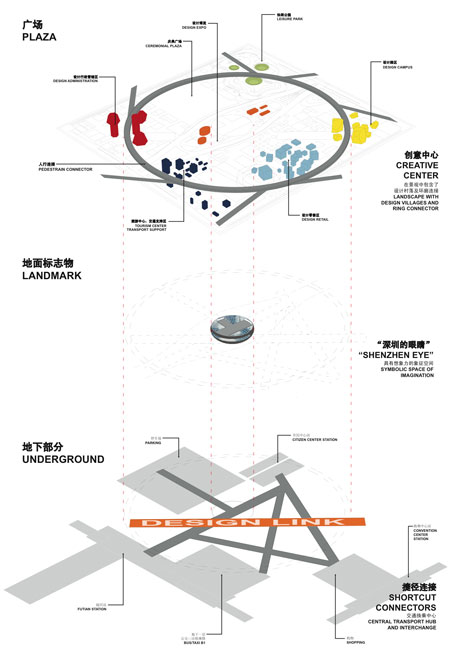
The scheme builds on Shenzhen’s newly acquired status of “City of Design”, awarded by UNESCO in 2008, and proposes for the city’s Crystal Island project the formation of ”Shenzhen Creative Center”: a focal point for the city’s creative industries in front of Shenzhen’s iconic city hall.

Above ground, Shenzhen Creative Center consists of a 20-hectare landscape of parks and gardens, populated by clusters of pavilions and small buildings – “Design Villages” – that form a vibrant micro-urbanism of public activity. The site is encompassed by an elevated pedestrian “Ring Connector”, an urban walkway joining its multiple elements and infrastructures.
 88. Forest Spiral - Hundertwasser Building (Darmstadt , Alemanha)
88. Forest Spiral - Hundertwasser Building (Darmstadt , Alemanha) 










 100. Casa de Pedra (Guimarães, Portugal)
100. Casa de Pedra (Guimarães, Portugal) 
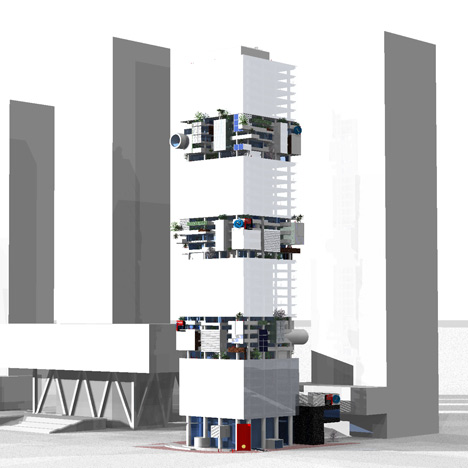
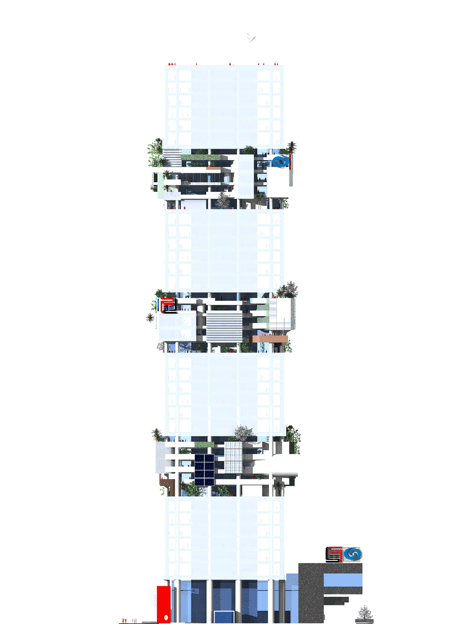
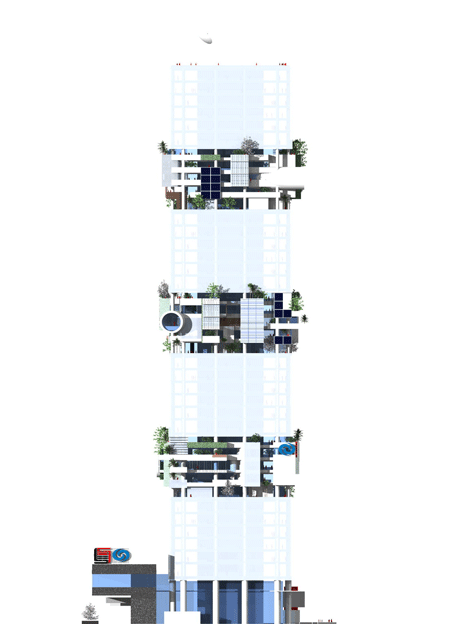
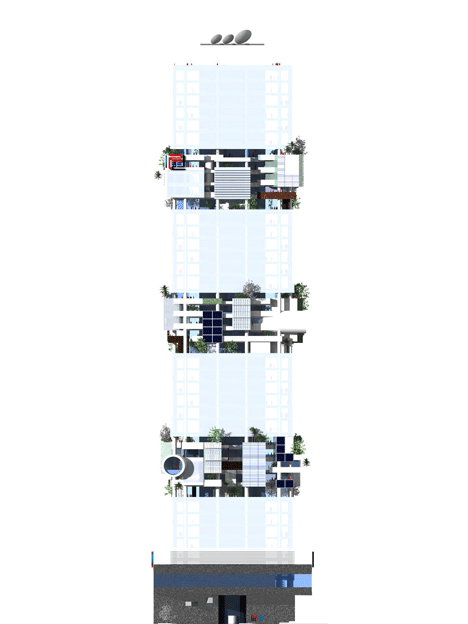
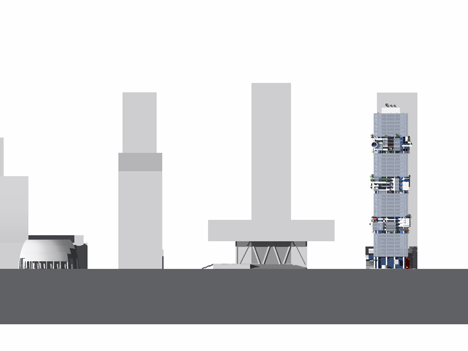
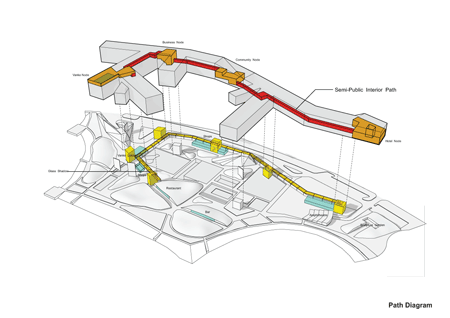


Secoin công ty hàng đầu về cung cấp vật liệu xây dựng tại Việt Nam
ReplyDelete------------
Công ty cung cấp vật liệu xây dựng tại tphcm
Web: http://http://gachbongcaocapsecoin.blogspot.com/
Click vào Keywords: Công ty cung cấp vật liệu xây dựng tại tphcm
Click vào Keywords: Cong ty cung cap vat lieu xay dung tai tphcm